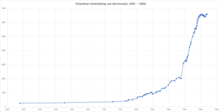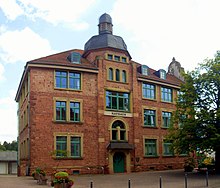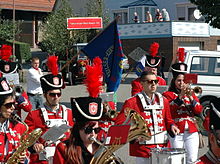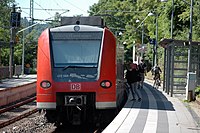Bammental
| coat of arms | Germany map | |
|---|---|---|

|
Coordinates: 49 ° 21 ' N , 8 ° 47' E |
|
| Basic data | ||
| State : | Baden-Württemberg | |
| Administrative region : | Karlsruhe | |
| County : | Rhein-Neckar district | |
| Height : | 125 m above sea level NHN | |
| Area : | 12.16 km 2 | |
| Residents: | 6561 (Dec. 31, 2018) | |
| Population density : | 540 inhabitants per km 2 | |
| Postal code : | 69245 | |
| Area code : | 06223 | |
| License plate : | HD | |
| Community key : | 08 2 26 006 | |
| LOCODE : | DE BTH | |
| Address of the municipal administration: |
Hauptstrasse 71 69245 Bammental |
|
| Website : | ||
| Mayor : | Holger Karl | |
| Location of the municipality of Bammental in the Rhein-Neckar district | ||
Bammental (before 1901: Bammenthal ) is a municipality with around 6500 inhabitants in the Rhein-Neckar district in Baden-Württemberg .
geography
Location and natural space
Bammental belongs to the Rhine-Neckar metropolitan region and is located in the Neckartal-Odenwald nature park , about 9 km as the crow flies southeast of Heidelberg and 13 km northwest of Sinsheim in the Elsenz valley . The district of Reilsheim belongs to Bammental.
Neighboring communities are in the northwest Heidelberg , in the north Neckargemünd , in the east Wiesenbach , in the southeast Mauer , in the southwest Leimen with the district Gauangelloch and in the west Gaiberg .
Bammental's area has a share of Kraichgau and Odenwald , in the northeast of the southeast slope of the Königstuhl . This consists largely of Upper Buntsandstein . The Hollmut ridge, a mountain circulating around the Neckar, protrudes into the area from the north. The Elsenz flows through the municipality in the south and southwest . Here there is a hill made of shell limestone covered with loess and hills made of Neckar gravel, which are covered with clay and loess and resemble the hills of the Kraichgau. The municipal area extends between a height of 120 and 340 meters over 1216 hectares. Of this, 18.8 percent are settlement and traffic areas, 35.1 percent are used for agriculture and 44.2 percent are forested.
The river Elsenz flows through Bammental and Reilsheim .
Community structure
The Bammental community includes the villages of Bammental and Reilsheim, the power station for the wallpaper factory and the Hollmut young cattle pasture.
climate
The annual precipitation is 929 millimeters. The rainfall is high. They are in the upper quarter of the values recorded in Germany. Lower values are registered at 80 percent of the measuring stations of the German Weather Service . The driest month is February, with the most rainfall in June. In June there is 1.3 times more rainfall than in February. Precipitation varies very little over the course of the year. Lower seasonal fluctuations are recorded at only 4 percent of the measuring stations.
history
Until the 19th century
Remnants of a Roman road and Roman buildings bear witness to a settlement by the Romans from the turn of the ages.
In 769 today's district of Reilsheim was first mentioned in a document from the Lorsch Codex under the name Risolfesheim . Reilsheim is one of the oldest settlements in the lower Elsenz valley, which were probably founded in the course of the Franconian conquest in the 6th or 7th century. A number of expansion settlements were founded from Reilsheim, including the Bammental, located on the lower reaches of the Krebsbach, whose origins are probably in the 8th or 9th century. The deed of gift of June 29, 1016 , in which Benemaden is mentioned for the first time, probably dates from the 12th century. Secure documents are only available from the 12th century. The two spatially separated places probably formed a common administrative unit as early as the 13th century, in 1325 a common mayor was named. Reilsheim and Bammental have grown together through the suburbs located between the old settlement centers , beginning with the settlement of a mill on the Elsenz in 1628 and massively expanded since the opening of the Elsenz Valley Railway in 1862 and the establishment of a wallpaper factory in 1862/63. The Vorstädtl today forms the actual community center with the town hall and shops.
Bammental-Reilsheim originally belonged to the high medieval Elsenzgau and then came with the lower Elsenztal in Staufer possession, which was administered by an imperial bailiff in Wimpfen . From 1330 to 1803 the place was under Palatine sovereignty and belonged to the Meckesheimer Zent , a judicial district encompassing the lower Elsenz valley. Various monasteries and the Lords of Hirschhorn had property in Reilsheim and Bammental, but over two thirds of the arable land was free property of the farmers. In the 18th century, Bammental developed into the larger of the two towns due to the immigration of farmers. In 1803 Bammental came to Baden . After 1831 Reilsheim tried temporarily to become self-employed, but this was finally rejected in 1841.
Bammental was dominated by agriculture and forestry well into the 19th century. The first large industrial enterprise in the area was the wallpaper and paper factory of the Scherer brothers, which opened in 1863 and in 1888 already had 200 employees. Around 1900, cigars and mills were also of further historical industrial importance.
20th century
After the Second World War , Bammental took in around 1,000 displaced persons , mostly from former German eastern regions, the Czech Republic, Hungary and Yugoslavia. This ensured a strong increase in the population and the development of new residential areas. The traditional branches of business such as paper and cigar production and milling lost their importance, but new industries were opened up during the “ economic miracle ” years. Until 1973 Bammental belonged to the district of Heidelberg . With its dissolution, the community fell to the Rhein-Neckar district .
Population development
| year | 1439 | 1577 | 1777 | 1834 | 1905 | 1939 | 1961 | 1965 | 1970 | 1982 | 1991 | 1995 | 2000 | 2005 | 2010 | 2015 |
|---|---|---|---|---|---|---|---|---|---|---|---|---|---|---|---|---|
| Residents | 255 | 285 | 501 | 903 | 1741 | 2041 | 3671 | 4207 | 4616 | 5560 | 6167 | 6397 | 6545 | 6517 | 6468 | 6426 |
politics
Municipal council
In addition to the presiding mayor, the municipal council has 18 members who are elected every five years.
The 2019 local elections led to the following result (in brackets: difference to 2014):
| Joint list CDU and BV | 5 seats (−2) |
| Green | 4 seats (+1) |
| SPD | 3 seats (± 0) |
| Pro Bammental | 3 seats (± 0) |
| Independent voters Bammental | 3 seats (± 0) |
The turnout was 68.4% (+16.9).
mayor
The mayor is directly elected for eight years. Mayor of Bammental is Holger Karl. He was elected on March 28, 2010 in the second ballot with 69.7 percent of the votes cast and took office on June 1, 2010. In March 2018 he was re-elected for another eight years with 70.86 percent of the vote.
Schultheissen
- 1325 - Konrad (Conrad)
- 1439 - Hanns Bersich
- 1495 - Hans Kühnle
- 1506 - Hans Gaul (Kaull)
- 1516 - Hans Seifert (Syfert)
- 1532–1554 - Fritz Obert
- 1554–1569 - Friedrich Zimmermann
- 1582–1595 - Friedrich Klingmann
- 1654 - Hans Leonhard Fromm (Frum)
- 1664–1669 - Hans Valentin Reinhard (Velten Rennert)
- 1669–1671 - Hans Wilhelm Gompenhaus (Kumpenhanß)
- 1674 - Hans Leonhard Fromm
- 1680–1702 - Hans Stephan Hossmann
- 1707–1726 - Georg Ganshorn (goose horn)
- 1729–1730 - Mathias Buschlaeger
- 1730–1731 - Hans Stephan Heid (Heyd)
- 1731–1735 - Bernhard Ganshorn
- 1735–1748 - Georg Michael Haeusser (Heisser, Heuser)
- 1748–1754 - Matthaeus Schneckenberger
- 1755–1776 - Johann Friedrich Roesch
- 1776–1790 - Caspar Harth
- 1790–1798 - Johann Heinrich Schneckenberger
- 1799–1824 - Mathias Sigmund (since 1810 Vogt)
Bailiff
- 1824–1826 - Georg Jakob Fromm
- 1826–1828 - Georg Heid
- 1828–1832 - Adam Hoffmann (mayor since 1831)
mayor
- 1832–1835 - Philipp Ganshorn
- 1835–1837 - Christian Hoffmann
- 1837–1848 - Leonhard Fromm
- 1848–1850 - Jakob Sigmund
- 1850–1874 - Leonhard Fromm
- 1874–1893 - Johann Friedrich Ziegler
- 1893–1903 - Johann Schenzel
- 1903–1914 - Phillipp Christian Rösch
- 1914–1919 - Friedrich Winnewisser
- 1919–1928 - Jakob Ziegler
- 1928–1933 - Emil Müller
- 1933–1944 - Heinrich Lämmler
- 1944–1945 - Heinrich Hoffmann
- 1945–1954 - Wilhelm Hessenauer
- 1954–1975 - Erich Renz
- 1976–1994 - Herbert Echner
- 1994–2010 - Gerhard Vogel
- since 2010 - Holger Karl
coat of arms
Blazon : split by a curved silver tip, in which a growing green deciduous tree separated by two growing red tulips with green leaves; in front in black a left-facing, red armored and red-tongued golden lion, in the back diagonally roughened with blue and silver.
The coat of arms goes back to a former court seal that has been traceable since 1747. It was officially recognized by the General State Archives in 1894. The lion and the diamonds are symbols of the old Electoral Palatinate . The tree stands for the folk etymological interpretation of “Bammental” as “tree in the valley”.
The flag is green and white and was awarded by the Interior Ministry in 1965.
Parish partnership
Bammental has had a partnership with Vertus (since 2018 part of the municipality of Blancs-Coteaux ) in France since June 18, 1966 and with the Saxon municipality of Demitz-Thumitz since the fall of the Berlin Wall in 1989 .
Culture and sights
Buildings
In the middle of the former settlement centers of Bammental and Reilsheim, two old watchtowers, so-called "Dörndl", from 1773/74 have been preserved. Above the suburb there is also the "Old Tower", the steeple of a church built in the 13th century, renovated in the Baroque style around 1774 and demolished in 1896. The new Protestant church was built from 1902 to 1904 according to plans by Hermann Behaghel and equipped with a new bell in 2007. The Catholic Church of St. Dionysius was built in 1912 and expanded from 1975 to 1977 with a modern extension. The New Apostolic Church in Reilsheim is a modern building from 1975. In addition to the town hall made of red sandstone typical of the region, the half-timbered old town hall, which was used as such from 1851 to 1956, has also been preserved. There are several other historic half-timbered buildings in the village , including a very ornate building from 1593 in the Reilsheim district.
Half-timbered house in Reilsheim from 1593
Museums
A local museum has been set up in the old train station in Bammental . The scented and medicinal herb garden at the "Old Tower" is also worth seeing.
Natural monument
There is a 1000 year old oak tree in Reilsheim. A fire caused by a lightning strike made the tree hollow inside. The inside of the tree is protected by foil and a roof.
Regular events
The Kerwe has been celebrated in Bammental for centuries on the third Sunday in August, the oldest evidence dates back to 1703. The parades of the Kerweborscht also have a long tradition . The summer trains before Easter, which are already in use in Bammental from 1654, also have a long tradition . The two-day Christmas market takes place in Oberdorfstrasse every December.
Every two years the Lindenfest is held, which is organized by the Bammental trade association, at which, in addition to concerts and a Sunday shopping, the duck race to promote the forest swimming pool is also regularly held. Alternating with the Linden Festival, the Bammental Spring Market also takes place every two years.
Every year, together with the Vertus twin partnership meeting Vertus - Bammental.
dialect
The local dialect is " Kurpellsisch " or in High German : the Palatinate dialect in Kurpfälzer form.
In the surrounding area, a Rhine Franconian dialect is "babbled" in countless small-scale variants, but High German and the proportion of newcomers has pushed the dialect back somewhat.
Economy and Infrastructure
traffic
The Elsenztalbahn , which comes from Heidelberg via Neckargemünd and Sinsheim to Bad Friedrichshall Hbf , has two stops in Bammental: the Bammental stop and the Reilsheim suburb. The route is served by the RheinNeckar S-Bahn with the Heidelberg – Sinsheim – Eppingen and Heidelberg – Meckesheim – Aglasterhausen lines. There are bus routes to the surrounding towns. Bammental belongs to the tariff area of the Rhein-Neckar transport association .
Bammental is on the federal highway 45 between Neckargemünd and Sinsheim.
education
There is evidence of a school in Bammental since 1605. Today there is the Elsenz Valley School, a primary and community school, the Bammental grammar school and the private Kurpfalz boarding school .
Personalities
Honorary citizen

- Johann Stetzelberger (1882–1962), long-time local councilor
- Emil Filsinger (1889–1972), longtime choirmaster, honorary citizen 1964
- Heinrich Müller (1919–1991), long-time councilor and fire brigade commander, honorary citizen 1975
- Herbert Echner (1940–1995), Mayor (1977–1994), long-time district councilor, honorary citizen in 1994
- Horst Ottinger (1938–2003), long-term chairman and councilor, honorary citizen in 2002
- Erhard Kramer (1933–2013), long-term councilor and first deputy mayor, holder of the Federal Cross of Merit, honorary citizen in 2009
- Hansi Flick (* 1965), professional soccer player, trainer and sports director, honorary citizen 2015
Sons and daughters of the church
- Wilhelm Kling (1902–1973), politician ( KPD , SED )
Other people associated with Bammental
- Ellen Lauterbach (1923–2011), member of the Bundestag (SPD) and holder of the Federal Cross of Merit, 1st class
- Axel Mehlmann (* 1946), Catholic pastor (1991–1997), Vicar General of the Archdiocese of Freiburg .
literature
- State Archive administration Baden-Württemberg in connection with d. Cities and districts Heidelberg u. Mannheim (Hrsg.): The city and districts Heidelberg and Mannheim: Official district description .
- Vol. 1: General part . Karlsruhe 1966
- Vol. 2: The city of Heidelberg and the municipalities of the district of Heidelberg . Karlsruhe 1968
- Günther Wüst: Bammental - history of an Elsenztalgemeinde . Mayor's office Bammental 1983
Individual evidence
- ↑ State Statistical Office Baden-Württemberg - Population by nationality and gender on December 31, 2018 (CSV file) ( help on this ).
- ^ The state of Baden-Württemberg. Official description by district and municipality. Volume V: Karlsruhe District Kohlhammer, Stuttgart 1976, ISBN 3-17-002542-2 . Pp. 384-385
- ↑ Bammental. Discover regional studies online Baden Württemberg, accessed on August 7, 2017 .
- ^ Elsenzaue-Hollmuthang nature reserve - once shaped by the Neckar (environmental theme park). Retrieved August 7, 2017 .
- ↑ State Statistical Office Baden-Württemberg, status: December 31, 2004 ( page no longer available , search in web archives ) Info: The link was automatically marked as defective. Please check the link according to the instructions and then remove this notice.
- ↑ Minst, Karl Josef [transl.]: Lorscher Codex (Volume 4), Certificate 2588, July 10th, 769 - Reg. 2520. In: Heidelberg historical stocks - digital. Heidelberg University Library, p. 177 , accessed on March 5, 2016 .
- ↑ Certificate No. 332 of the Old Collection of the Heidelberg University Library
- ^ Up to 1965: District description, vol. 2 , p. 402. Thereafter: Statistical State Office Baden-Württemberg .
- ^ State Statistical Office of Baden-Württemberg: Municipal council elections 2019, Bammental ; Bammental municipality: municipal council elections 2019 (PDF) ; accessed June 1, 2019.
- ^ Rhein-Neckar-Zeitung , Heidelberger Nachrichten, June 2, 2010, page 8
- ^ Herwig John, Gabriele Wüst: Wappenbuch Rhein-Neckar-Kreis . Ubstadt-Weiher 1996, ISBN 3-929366-27-4 , p. 40
- ↑ Web Commerce GmbH www.w-commerce.de: St. Dionysius, Bammental. Retrieved on August 7, 2017 (German).
- ↑ Hansi Flick is Bammental's youngest honorary citizen rnz.de November 23, 2015
Web links
- Bammental municipality
- Bammental at leo-bw.de (discover regional studies online, Baden Württemberg)
- St. Dionys, Bammental near the pastoral care unit Neckar-Elsenz with pictures and detailed building history






















